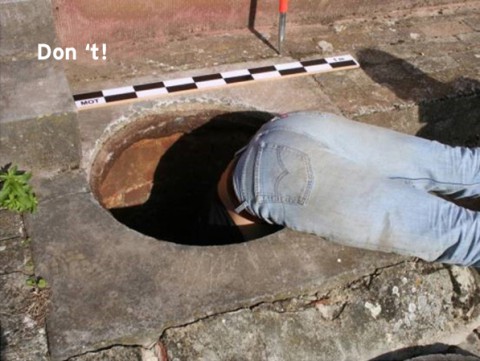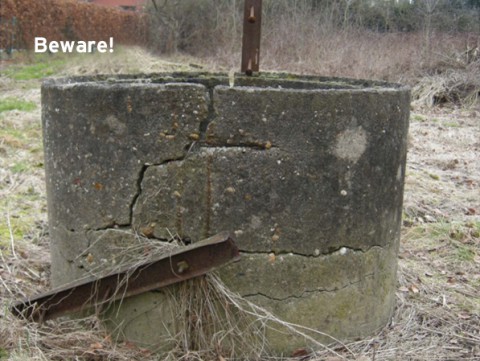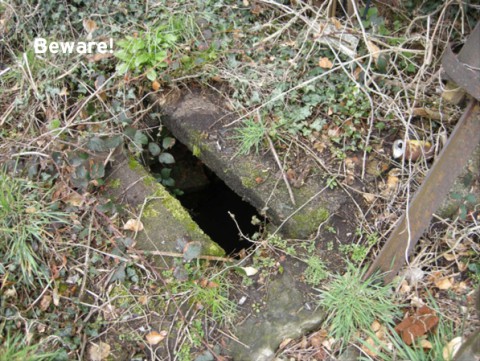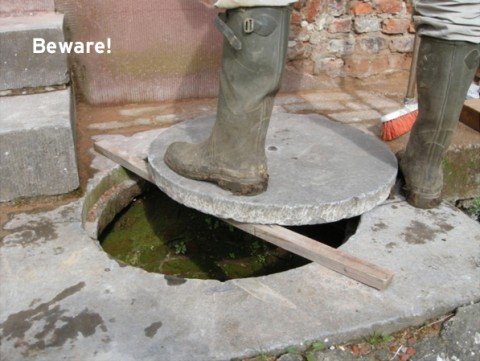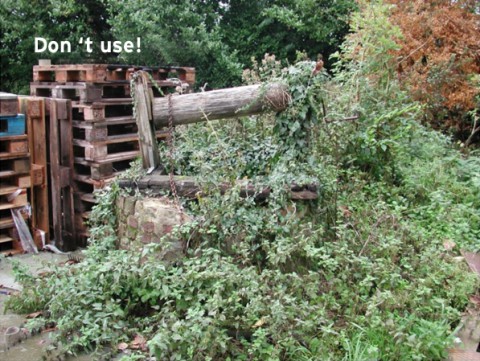Guidelines for measuring a well
basic material
- Yardstick
- Water- and dirt resistant tape measure (20 meters)
- 20 meter-long rope, around 5 mm diameter (for example to let down the gas lamp
- Little snaphook
- Plumb bob; tool for depth sounding (weight of 250-500 grams)
- Something to write down and take notes
- Binder for cards and notes
- Print of inventory card
- Print of fieldsheet
- Camera
- Scale for photos
- Gas lamp
- Matches
- Rag for hands and material

in addition
- Small rope to lift up the lid with a wing knob
- Two round pins to put into the ground
- Guide pen
- Small hammer
- Trowel
- Small shovel (to clear lids)
- Small brush
- Small plastic bags (for wet rag and other stuff)
- Small drag (if something falls into the well)
- Second gas bottle for gas lamp
- Gas mantle for gas lamp
- Matches (to burn new gas mantle)
- Flashlight
- Pruning shears
- Gloves
- For wearers of eyeglasses a string for the glasses
- Measuring rod




measuring rod
alternatives
- You should use the tape measure of 20 meters to measure the depth of the well. This tape measure can be replaced by a rope of 20 meters. Attach the plumb bob to the end of the tape measure or the rope and lower it into the well. Afterwards you can measure the length by using a yardstick or tape measure.
- The plumb bob can be replaced by a brick or other object. This will help to put additional weight on the rope in order to measure the depth of the well.
- The scale for photos can be replaced by a simple pen, a matchbox, an umbrella… In short, something we all know the size of.
conditions
- Only dug wells fuelled by ground water can be included in the inventory; this means: no rainwater manholes, wishing wells etc. Invisible wells, however, that are no longer used, filled or covered may be included in our inventory. A good imitation of a well is sometimes difficult to distinguish from a real one.
- The inventory card refers to the current state of the well. If prior situations are known, these can be mentioned in the “Comment” section.
- Note down what you exactly measure (in centimetres, not metres).
- If you have to give the diameter when measuring, it always implied the inner diameter.
- On the enclosed “field sheet” you can find an explanation of several terms.
how do I fill in the form?
- Make sure to keep your notes dry. They can all too easily fall into the well or a puddle and sometimes they can even become unreadable because of the rain!
- There is only one mandatory field: the address, i.e. city (no boroughs), street, house number (or the house number of the nearest house).
- Before you measure the depth of the well, make sure to have a look at the walls of the well and take a picture. Afterwards it could turn out that by measuring the depth the sludge on the soil comes off and this could make the water look muddy.
-
The depth from the surface to the bottom of a well can easily be measured with the help of a tape measure (in most cases 10 meters will do!). At the end of the tape measure you can attach a plumb bob with a little snap hook.
Measure the depth from the upper edge of the well to its bottom. After that, you measure the height of the superstructure from the ground to the upper edge. The depth of the well is actually the depth from the upper edge to the bottom minus the height of the superstructure.
This is the current state. Probably there’s some low sludge on the bottom.

- The depth until the water surface is measured in the same way. Instead of measuring till the bottom, you measure till the water surface. Also here you measure till the upper edge and afterwards you subtract the height of the superstructure from the resulted depth.
- A well stone closes in a tapered way. In most cases, however, a well stone is not easily recognized. In that case, you should note that it is a brick by ticking of the box. Only check ‘well stone’ if you’re sure about it (on the outside of the well the stone is wider than on the inside).

-
The diameter of the wellhead above the ground can often easily be measured. By this we mean the inner diameter of the opening at the same height of the upper edge. To do this efficiently, you should use a yardstick.

- The circumference of windlass’s drum can be measured with a tap measure. Do not measure the diameter in the middle, because the drum has probably eroded there, do measure it on the edge instead.

- The length of the windlass’s crank handle can be measured with a yardstick or a tap measure. On the picture you can see what we mean by the length.

safety and risks
We recommend you to stay focused when measuring the well. There are several risks, both above (e.g. falling into the well with possible wounds or even drowning) as well as in the well (suffocation, drowning, walls coming loose, objects falling into the well etc.). Safety precautions may prevent you from filling in this card completely, but… safety first!
Of course, there are also minor risks such as dropping objects into the well. A treble can be useful to recuperate fallen objects. Attach it to a rope.
some safety tips
- Hold a child if it likes to peer into the well.
- Do not lean against the superstructure if you’re not sure about its firmness.
- Do not leave a well alone without cover, not even for a minute.
- Beware of “hidden” water wells (including rainwater manholes and cesspits), of which the opening is at the same height as the ground level; in most cases, they cannot be distinguished from the ground surface.
- Beware of unstable covers, especially if they equal the ground.
- Do not go at any time into the well when you’re inexperienced or alone. There could be gasses or objects falling down, or the walls could collapse etc.
- Do not use the present lift structure to descend into the well. This structure is often not designed to carry the weight of people. Above that, the structure is regularly already rotten or worn down.
